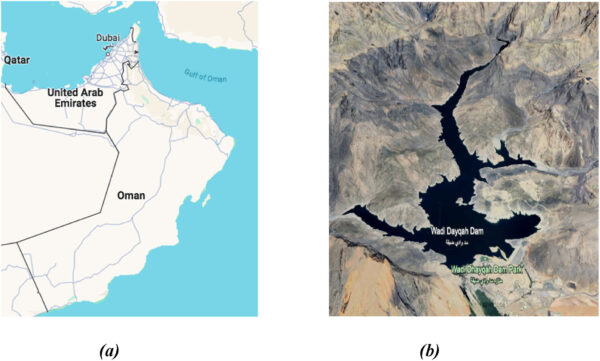Scientists from the United Kingdom's University of Exeter have investigated the potential of installing a floating PV (FPV) farm on Oman's Wadi Dayqah Dam and coupling it with a hydrogen storage system.
Using several software programs to simulate and optimize the project size, the researchers found that the project is technically viable, although at a relatively higher levelized cost of hydrogen (LCOH).
“The proposed location for the FPV system is Wadi Dayqah Dam, located in the northeastern region of the Sultanate of Oman, about 83 km southeast of Muscat in Qurayat,” said the scientists. “The reservoir, covering an area of 350 ha, is formed by two dams. The dam boasts an annual average global horizontal irradiation of 2,083.6 kWh/m2 and maintains a moderate average annual ambient temperature of 28.43 C.”
The researchers used the PVsyst software to construct the FPV system. They identified a 130,000 m2 area in the reservoir with minimal shading from the surrounding mountains. Then, they simulated the use of a bifacial silicon monocrystalline module with 635 W and an efficiency of 20.5%. The system cost was estimated at $1,260/ kW, with an expected lifetime of 25 years.
“Due to a lack of specific data regarding the annual electricity consumption per household in Oman, an assumption was made using the average household size in Oman of 7.2 individuals and the annual electricity consumption per capita in Oman of 8.274 MWh,” the academics said. “This calculation yields an estimated annual electricity consumption per household of 60 MWh/year. This figure was then utilized to determine the number of households the proposed system can cover their electrical requirements.”

Image: University of Exeter, International Journal of Hydrogen Energy, CC BY 4.0
For the hydrogen storage system, the HOMER Pro software was used to optimize its size with the minimum energy cost. The scientists assumed to use a proton exchange membrane (PEM) electrolyzer with a capital cost of $2,500/kW and a lifetime of 15 years; a PEM fuel cell with a cost of $2,500/kW and a lifetime of 60,000 hours; a hydrogen tank that costs $1,000/kW and lasts for 15 years; and a converter with a cost of $300/kW and 15 years, respectively.
As for the storage system, the optimization tool indicated an optimum electrolyzer capacity of 22 MW, a storage tank of 60,000 kg, a fuel cell of 13 MW, and a converter of 12.4 MW. “With an installed capacity of 26.57 MW, the FPV system incorporates 41,847 bifacial modules. The system demonstrates a specific production rate of 1947 kWh/kWp/year, resulting in a total annual energy production of 51.734 GWh/year,” the researchers added.
The entire system was found to generate 65.516 GWh of electricity annually, with the FPV system accounting for 79% of the total electricity production, while the fuel cell accounts for the remaining 21%. “The modeled system achieves a renewable fraction of 100%, demonstrating its capability of fulfilling 100% of energy demand with renewables. The domestic electric load consumes 25.3 GWh annually, representing 422 households,” the research team specified.
The economic analysis of the system resulted in a high levelized cost of electricity (LCOE) of $0.97/kWh and LCOH of $29.7/kg, which is attributed to substantial capital and operating expenses associated with the large-scale system components and fuel cell inefficiency losses. “The economic viability may be improved in the future with advancements in hydrogen energy storage technology and rising fossil fuel prices,” the academics concluded.
Their findings were presented in “Investigating the integration of floating photovoltaics (FPV) technology with hydrogen (H2) energy for electricity production for domestic application in Oman,” published in the International Journal of Hydrogen Energy.
This content is protected by copyright and may not be reused. If you want to cooperate with us and would like to reuse some of our content, please contact: editors@pv-magazine.com.



1 comment
By submitting this form you agree to pv magazine using your data for the purposes of publishing your comment.
Your personal data will only be disclosed or otherwise transmitted to third parties for the purposes of spam filtering or if this is necessary for technical maintenance of the website. Any other transfer to third parties will not take place unless this is justified on the basis of applicable data protection regulations or if pv magazine is legally obliged to do so.
You may revoke this consent at any time with effect for the future, in which case your personal data will be deleted immediately. Otherwise, your data will be deleted if pv magazine has processed your request or the purpose of data storage is fulfilled.
Further information on data privacy can be found in our Data Protection Policy.